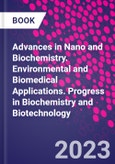Advances in Nano and Biochemistry: Environmental and Biomedical Applications gives insights into this advanced interdisciplinary science that encompasses the principles of physics and physical chemistry for the investigation of various processes and problems in biological systems. The book is a concise culmination of biophysical chemistry knowledge acquired through core concepts and advanced technologies for addressing emerging challenges in environmental and biomedical applications. Sections cover early diagnostic techniques and accurate treatment strategies using bioinspired, sustainable technologies, including nanomaterials, nanoenzymes, biopolymers, electrochemical biomolecule sensors, biocompatible magnetic nanomaterials, quantum dots and hybrid structures, and DNA nanotechnology.
Other sections discuss advanced technologies for sensing and remedying environmental pollutants, including but not limited to, photocatalytic oxidations, gum polysaccharides based nanostructured materials, bio-inspired and biocompatible nanomaterials, hydrogel nanocomposites, and contemporary enzymes and nanozymes based?technologies. Ultimately, the state-of-the-art chapters in this book will empower researchers to combine two complementary elements - chemical analysis use and biomedical applications.
Please Note: This is an On Demand product, delivery may take up to 11 working days after payment has been received.
Table of Contents
Section I: Environmental Studies
1. Coupling of photocatalytic and bioremediation processes for enhanced mitigation of xenobiotic pollutants from waste water
2. Bio-inspired nanomaterials for remediation of toxic metal ions from wastewater
3. Biocompatible nanomaterials for sensing and remediation of Nitrites and Fluorides from polluted water
4. Role of gum nanostructured hydrogels in water purification, desalination and atmospheric water harvesting applications: Advances, current challenges and future prospective
5. Versatile nanomaterials for remediation of microplastics from the environment
6. Plastic degradation- Contemporary enzymes versus nanozymes based technologies
7. Current Trends in Sensing and Remediation of Gaseous Pollutants from the Atmosphere
8. Emerging non-noble metal nanocatalysts for complete mitigation of combustion generated CO, NOx and unburnt hydrocarbons
9. Advanced methodologies for remediation of combustion generated particulate matter (Soot) from the environment
10. Recent advances in Quantification and remediation technologies for toxic PAH mitigation from the environment
Section II: Biomedical Studies
11. Application of nanoparticles as quorum quenching agent against bacterial human pathogens: A prospective therapeutic nano-weapon
12. Biocompatible green-synthesized nanomaterial for therapeutic applications
13. Toxicological aspects of nanomaterials in biomedical research
14. Quantum dots and hybrid structures as an innovative solution for bioimaging and diagnostics of viral infection
15. Magnetic Nanomaterials and Their Hybrids for Magnetic Hyperthermia
16. Advanced functionalized nanomaterial-based electro active biomolecules as sensors for disease diagnosis
17. Recent advances in MOFs based nanocomposites for treatment of retinopathy or retina related biomedical applications
18. Recent advances in supramolecular organic nanostructures for drug delivery applications
19. Recent advances in biopolymers for drug delivery applications
20. Regenerated silk sericin from Antheraea mylitta and Bombyx mori as potential biomaterial
21. Structural DNA nanotechnology and its biomedical applications








